Code of practice for stop and search in Scotland: six-month review
Report on behalf of the Independent Advisory Group on Stop and Search presenting the findings of the interim six month review.
6 Searches and seizures for people with protected characteristics
6.1 Introduction
In recent years, a series of research reports (Murray 2014, 2015; Murray and McVie 2016; McVie and Murray 2017) have highlighted the high degree of disproportionality in the use of stop and search amongst children and young people in Scotland. These reports also found that rates of stop and search were higher amongst men than women, and there were some ethnic disparities (although the lack of accurate population data on minority ethnic groups means that no conclusions can be drawn about ethnic bias). During the public consultation on stop and search, there was significant concern about the approach to searching children and young people and how this might impact on their attitudes to, and cooperation with, the police. As a result, Section 7 of the CoP specifically addressed the issue of searches involving children and young people, and Police Scotland provided training for all officers aimed at improving methods of engagement with young people. The training also examined the issue of unconscious bias when dealing with any individuals with other protected characteristics. This section of the report examines whether there have been any changes in the profile of searches following the introduction of the CoP and whether rates of search appear to be disproportionately high and detection rates disproportionately low in respect of any group with protected characteristics, especially children and young people.
6.2 Change in search and seizure rates by age, sex and ethnicity
Age
Rates per capita were calculated using the number of searches and seizures across different age groups in order to determine differences in the extent to which these tactics are applied taking account of population size. Figure 11 shows a comparison of search rates by age across a series of different age groups in the six month period after introduction of the CoP and in the equivalent six month period of the previous year. It is clear that during both time points, those aged between 16 and 20 were the most likely within the population to experience a search; however, the rate of search declined markedly within this age group. The search rate amongst 16-17 year olds fell by 38%, which was far greater than any other group and made it on a par with searches of 18-20 year olds. It is notable, however, that search rates declined for all age groups, which would be expected given the overall decline in numbers of searches. So, while there was still a disproportionate use of search amongst younger people, the evidence suggests that this reduced significantly following the introduction of the CoP.
Figure 11: Change in rate of statutory search by age group
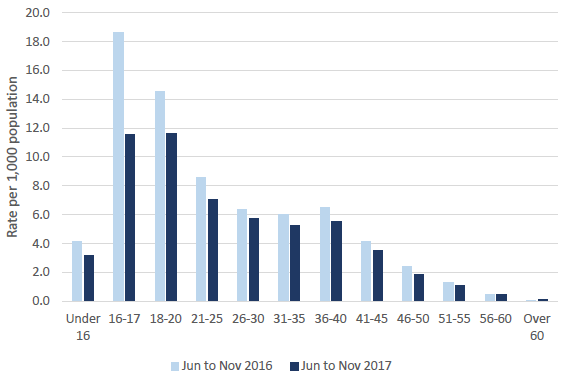
Figure 12: Change in rate of seizure by age group [6]
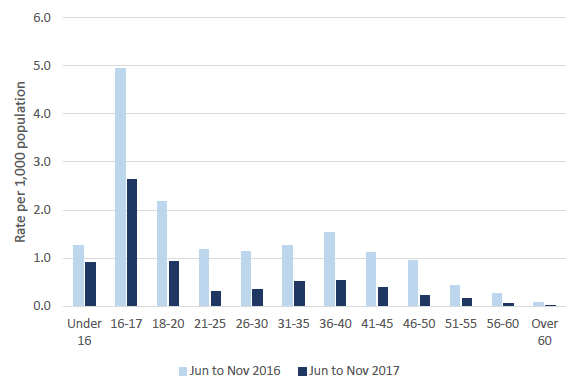
Figure 12 compares the seizure rates by age group during the same two equivalent six-month periods. Seizure rates were much lower than search rates overall; however, the extent of the reduction in numbers after the introduction of the CoP has clearly had an impact across all age groups. There were large percentage declines of 60% or more in seizure rates for all groups over the age of 18. For those under 18, the rate of seizures fell, albeit to a lesser extent. For those aged 16-17 the seizure rate fell by 47% and for those aged under 16 seizure rates declined by only 28%. This is most likely explained by the importance placed by Police Scotland on reducing harm caused by under-age drinking. The fact that the overall change in seizure rates was lower for those aged under 18 than for older age groups in the six months following the introduction of the CoP compared to the equivalent period in the previous year is in line with the findings presented in Table 5, above. Unfortunately, the numbers are too small to examine the change in rates on a month by month basis for so many different age groups.
Sex
The number of searches and seizures amongst males in the population has always been significantly higher than that for females and this picture did not change following the introduction of the CoP. In the six months since the CoP was introduced, males accounted for 87% of all statutory searches and 79% of all seizures. However, there was a greater decline in the number of both searches and seizures amongst males than females in the six month period following the introduction of the CoP. In fact, the number of statutory searches was 20% lower for men but only 5% lower for women in the six month period after the CoP was introduced compared to the equivalent six month period of the previous year; and the number of seizures was 62% lower for men but only 51% lower for women.
The rates of search and seizure for males and females across the different age groups were broadly similar to those observed in Figures 11 and 12. To identify where there were key differences, Figure 13 shows the percentage difference in the rate of statutory search between June to November 2016 and June to November 2017 by sex and for different age groups. It can clearly be seen that the rate of search declined for men across all age groups, especially amongst those age 16 to 17. The rate of search also declined for women aged under 18 and those aged 20 to 35; however, there were slight increases in the rate of search for other age groups. Further analysis of these figures found that the main reason for the increase amongst women was the introduction of recorded searches under warrant (which was introduced by the 2016 Act). As the number of searches amongst women aged over 35 was very small, the addition of this new category of searches increased the overall total. However, the introduction of searches under warrant for men did not have the same effect because the overall number of searches for men was so much larger.
Figure 13: Percentage difference in rate of statutory search by age and sex before and after CoP
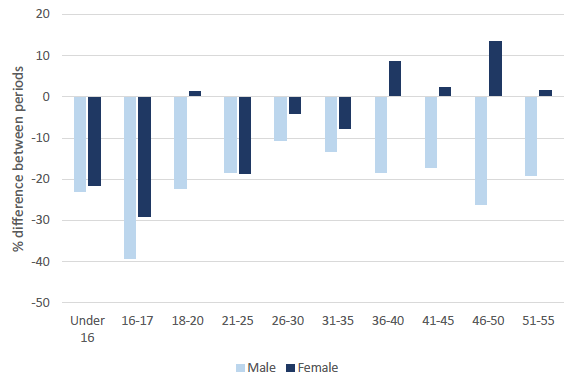
The percentage difference in seizures between the two time periods is shown for males and females by age group in Figure 14. Again, caution should be taken in interpreting the figures as some of the numbers are very small (especially for women); however, this chart shows that the rate of seizure declined for both men and women across all age groups. There are some differences in terms of the extent of the difference but, overall, Figure 14 suggests that the changing seizure rate affected both sexes more or less equally.
Figure 14: Percentage difference in rate of seizures by age and sex before and after CoP
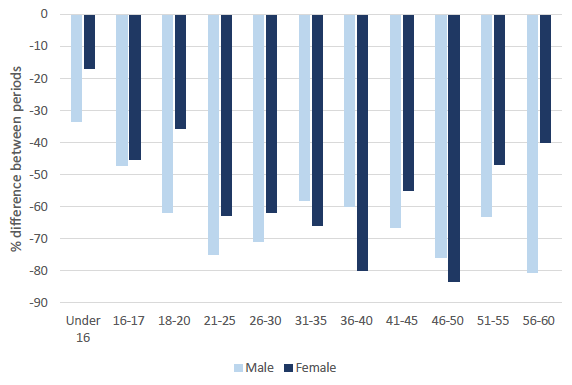
Ethnicity
As noted in earlier research (Murray 2014; McVie and Murray 2017), the vast majority of searches and seizures in Scotland involve people who self-define as white. This continued to be the case following the introduction of the CoP, with 78% of all searches and seizures involving people who self-defined as white Scottish and a further 9% who stated they were from another white background (e.g. White English or Polish). Overall, 87% of all searches and seizures were recorded as involving a white person in the six months after the CoP came into being, which was a significant reduction in the relative share of all searches from 92% in the equivalent six months prior to the introduction of the CoP. This reduction is mainly accounted for by an increase in the proportion of people for whom the person’s ethnic status was recorded as ‘unknown/not recorded’ (from 2% of all searches and seizures prior to the CoP to 9% afterwards). It is unclear from the analysis presented here why this increase has occurred, so this issue would benefit from further examination in the 12 month review.
The overall decline in the number of searches and seizures was experienced differentially by those from different ethnic backgrounds. The number of searches and seizures amongst white people declined by 32% from 22,252 to 15,186 between these two time periods. This was a far smaller decline than that for other ethnic groups, however. For example, the number of searches declined by 40% for those defined as Asian, 48% for those defined as Black African and 54% for those defined as Black Caribbean. The proportion of those in the ‘other’ ethnic category declined the greatest amount at 76%, although the numbers were very small. These findings indicate a greater than expected reduction in searches involving those from non-white backgrounds.
When refusals are excluded from the analysis, the relative share of all searches and seizures involving white people actually increased from 94% to 96%. This brings it in line with the estimated proportion of the population from White backgrounds according to the 2011 Census and would suggest that there is no overall ethnic disproportionality at a national level. However, this could only be properly ascertained if more was known about those for whom ethnic identity was not recorded. This issue requires further investigation and should be considered in more detail by the 12 month review.
Looking at the difference in the rate per capita of search by ethnic group in the six month period after the introduction of the CoP compared to the equivalent period in the previous year, Figure 15 reveals the extent of the decline in search rates for the Asian, Black Caribbean and other ethnic group categories. The search rate for all non-white ethnic groups (with the exception of Black African) appears to be higher than that for white people. However, as noted in earlier work (McVie and Murray 2017), caution must be taken in interpreting these rates for three main reasons. Firstly, the actual number of searches involving non-white people is far smaller than that for white people and so rates may be artificially inflated; secondly, the only available national population data for ethnicity is based on data from the 2011 Census which is highly rounded and may be significantly out of date; and thirdly, the stop and search database does not identify individuals who were subject to multiple searches and, therefore, rates may appear greater than they actually are (especially if multiple searches are more common amongst non-white than white people).
Figure 15: Difference in rate of statutory search by ethnic group before and after the CoP
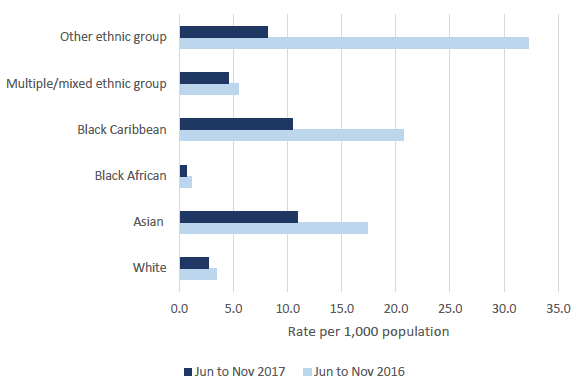
6.3 Change in positive detections by age, sex and ethnicity
The rates per capita, as set out in the previous section, provide valuable information about the extent to which search and seizure are used for different groups of the population. However, it is difficult to establish anything about disproportionality and fairness without having underlying information about the level of demand on policing caused by different groups. An equally important factor is to examine the extent to which searches result in a positive detection in order to identify whether certain groups may be being searched on the basis of lower levels of suspicion compared to others. As noted in section 2.2, above, the overall detection rate in the six month period after the CoP was introduced was 37%, an increase of 7% on the equivalent period of the previous year. This section of the report examines whether there was any significant change in the detection rate by age, sex and ethnicity following the introduction of the CoP
Age
The change in the positive detection rate for statutory searches by age group is shown in Figure 15A. It is evident that the positive detection rate was higher for all age groups following the introduction of the CoP; however, there was a greater proportionate increase for some groups than others. The lowest percentage increase in detection rates was for those aged 26-30 (14%) and 31-35 (11%), while the highest percentage increase was for those aged 46-50 (43%) and 51-55 (50%). There was also a large increase in positive searches amongst young people of 34% for those aged under 16 and 40% for those aged 16-17. These findings suggest that the overall reduction in number of searches since the introduction of the CoP has resulted in more positive outcomes across all age groups. Moreover, the greatest improvement in positive outcomes has occurred amongst those age groups for which the positive rate was previously lowest, which has resulted in greater equality across age groups – especially for those aged 18 or over. This suggests that the requirement for reasonable suspicion is being applied more evenly amongst adults. Nevertheless, there is still room for improvement in increasing the positive search rate amongst children and young people.
Figure 15A: Percentage change in positive statutory searches by age group before and after CoP
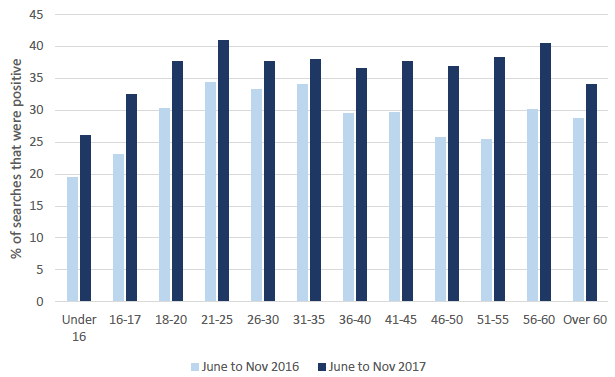
Sex
The proportion of all statutory searches resulting in a positive detection also increased for both males and females. Figure 16 shows that in the six months following the introduction of the CoP the percentage of positive detections increased for both males and females. Overall, there was no significant difference in the positive detection rate between males and females at either of the two time periods. Therefore, although the overall rate of search declined more for males than for females, there is no indication that this resulted in a biased approach to decision making.
Figure 16: Percentage change in positive statutory searches by sex before and after CoP
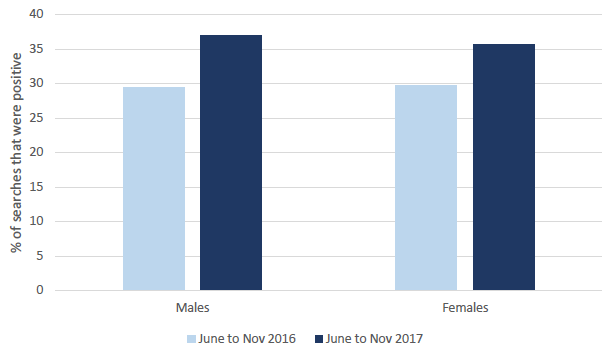
Ethnicity
There was also an increase in positive detection rates for statutory searches involving all ethnic groups, as shown in Figure 17. The percentage increase in detections following introduction of the CoP was lowest for searches involving Black African (19%) and white (25%) people and highest for multiple/mixed groups (67%) and those from other ethnic minorities (114%), although the numbers in these groups were very small. Again, therefore, the significant reduction in the number of searches amongst ethnic groups coincided with a large increase in the likelihood of a positive detection, which suggests that there were improvements in decision making around reasonable suspicion.
Figure 17: Percentage change in positive statutory searches by ethnicity before and after CoP
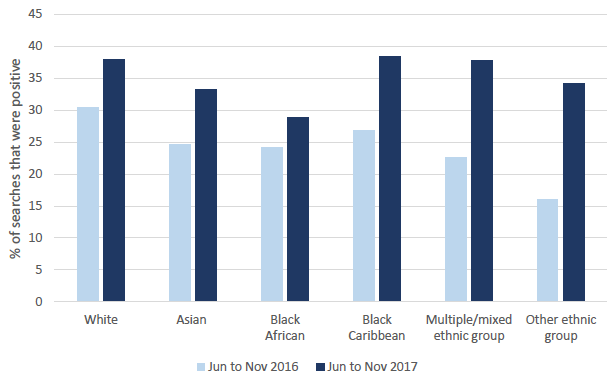
6.4 Evidence from Calls for Feedback
According to the Police Scotland report (see Appendix 1), there were no specific issues raised by police officers about difficulties in the use of search or seizure as a result of protected characteristics, other than those discussed earlier in this review relating to searching young people for alcohol.
6.5 Summary
A series of research reports have highlighted disproportionality in the use of stop and search amongst children and young people. Therefore, this review examined whether the introduction of the CoP had resulted in any change in terms of the use of search for those of certain ages or other groups with protected characteristics. Only three variables were available for analysis in the Stop and Search Database: age, sex and ethnicity. The analysis found that levels of search had reduced across all ages and, while young people in their mid to late teens continued to be the most likely group to experience a search, the degree of disproportionality in terms of targeting these groups had significantly declined in the period following the introduction of the CoP.
Rates of seizure had also declined significantly across all age groups; however, the seizure rates had declined less for young people under the age of 18 than for older people, most likely due to continued concern about policing alcohol-related harm amongst young people in Scotland. The total number of searches and seizures had also declined for both males and females following the introduction of the CoP. For some older age groups the rate of search had increased for females, although this was mainly due to the introduction of searches under warrant which inflated existing small numbers. In terms of ethnicity, searches and seizures predominantly involved white people both before and after the introduction of the CoP. There was evidence that the rate of searches for non-white people had declined across all ethnic groups, and that the level of search now broadly matched the population figures. Nevertheless, search rates per capita appeared to be higher for non-white ethnic groups than for white people, although there are strong health warnings around the calculation of population rates using ethnicity data. There was a large increase in the proportion of cases for which ethnicity was recorded as ‘unknown/not provided’ which is deserving of further consideration in the 12 month review.
Differences in absolute levels of search are not necessarily problematic if the detection rates do not indicate biased decision making practices. In this review, there was a significant increase in the positive detection rates for all age groups after the introduction of the CoP, particularly for the under 18s and those aged over 45 (for whom positive rates had previously been lowest), although there is still room for improvement with regards to young people under 18. There was also a significant increase in positive detection rates for both men and women, with no difference between the sexes. Detection rates also improved amongst all ethnic groups, especially those from multiple/mixed groups and other ethnic minorities, although numbers in these groups were small. Overall, these findings indicate that the reduction in the number of searches following the introduction of the CoP has coincided with an increase in the positive outcome of such encounters, and that this is true across all groups with protected characteristics.
Recommendations for the 12 month review:
9. To examine the disproportionality in the use of stop and search amongst young people under the age of 18 and the lower positive search outcome amongst this group.
10. To examine the reasons for the increase in the recording of ethnic status as ‘unknown/not recorded’.
Contact
There is a problem
Thanks for your feedback